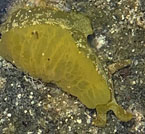| Home |
| Acknowledgments |
| Conventions |
| Glossary |
| Maps |
| References |
| Links |
| Articles |
| Thumbnails |
| Species
list |
| Family |
| Next species |
Additional Photos

2nd animal

large

side

front

rhinophores

underside

swimming

Syphonota geographica (A. Adams & Reeve, 1850)

| Maximum size: about 70 mm. Identification: This is an olive-green species intricately patterned in cream flecks and lines. The parapodia are high and the rhinophores are small, close-set and located far back on the head near the anterior margin of the parapodia. Natural history: On Maui, Syphonota geographica is known from about six animals found on sand at 6-7 m (20-22 ft). (Note 1) Like Aplysia reticulata, it may engage in sustained swimming. (Note 2) Elsewhere, the species feeds on the sea grass, Halophila sp. The Oahu animal was found in a tide pool at < 1 m (3 ft). (Note 3) Distribution: Big Island, Maui, Oahu and Midway: circumtropical. Taxonomic notes: It was first found in Hawaii at Maalaea Bay, Maui by Patty Daly on July 14, 2021. Photo: Rebecca Bicker: about 25 mm: found by Patty Daly; Maalaea Bay, Maui; July 14, 2021. Observations and comments Note 1: Rebecca Bicker reported that the 1st animal "moves just like an inchworm" suggesting that it crawls in a manner similar to Aplysia juliana. However, she reported that the 2nd animal did not crawl in that manner. She also said that the 1st animal was one of a group of around four when found. Note 2: Ryan Boerema found one swimming in the water column, at night, at a protected site with a silty bottom. It was initially seen at a depth of about 1 m (3 ft), then swam into deeper water while observed (over a period of at least seven minutes). Note 3: Perhaps, the shallow animal swam in? |
| Thumbnails |
Species
list |
Family | Next species | Top |